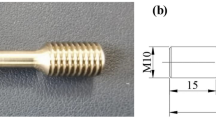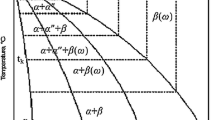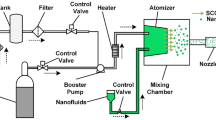Abstract
This study is intended to fill up the deficiency of the high-speed cutting (HSC) machining mechanism for TC17 Ti alloy. In this study, as the study object, TC17 Ti alloy is placed in room temperature (20 °C), ultra-low temperature (− 60 °C), and ultra-high temperature (350 °C) for HSC experiment, respectively, both through single-medium minimum quantity lubrication (SMMQL) and oil-water minimum quantity lubrication (OWMQL). The experimental results show that the main cutting force decreases by 33% during oil-medium MQL to 50% during water-medium MQL as compared to machining during dry cutting at room temperature; the cutting force decreases by 25% at the low temperature to 55% at the high temperature as compared to machining during OWMQL at room temperature; the cutting roughness decreases by 27% at the low temperature to 43% at the high temperature as compared to machining during OWMQL at room temperature. In the temperature of − 60 °C, the abrasion of the cutter mainly shows thermal cracking and adhesive wear during dry cutting. The cutter mainly shows crater wear during SMMQL of water; the abrasion mainly shows boundary and notching wear during SMMQL of oil, and the cutter also presents self-repairing function. In the temperature of − 60 °C, cutting layer TC17 titanium alloy produced a large dislocation, chip form appears collapse broken chip during OWMQL. In room temperature, there are more coarse second-phase precipitated in the cutting layer metal, the chip form is cracked during OWMQL. In the temperature of 350 °C, the material properties of the TC17 titanium alloy of the cutting layer will be restored to the state after the solution treatment in a short time. A large amount of the diffuse phase disappears. At the same time, grain boundaries show excellent continuity, and the Guinier-Preston enrichment area formed in the grain boundary, and the chip form exhibits a crumb during OWMQL.
Similar content being viewed by others

References
Hadad MJ, Tawakoli T, Sadeghi MH, Sadeghi B (2012) Temperature and energy partition in minimum quantity lubrication-MQL grinding process. Int J Mach Tools Manuf 54:10–17
Hadad M, Sadeghi B (2012) Thermal analysis of minimum quantity lubrication (MQL) grinding process. Int J Mach Tools Manuf 63:1–15
Maruda RW, Feldshtein E, Legutko S, Krolczyk GM (2016) Analysis of contact phenomena and heat exchange in the cutting zone under minimum quantity cooling lubrication conditions. Arab J Sci Eng 41(2):661–668
Krolczyk GM, Maruda RW, Nieslony P, Wieczorowski M (2016) Surface morphology analysis of duplex stainless steel (DSS) in clean production using the power spectral density. Measurement 94:464–470
Maruda RW, Krolczyk GM, Nieslony P, Wojciechowski S, Michalski M, Legutko S (2016) The influence of the cooling conditions on the cutting tool wear and the chip formation mechanism. J Manuf Process 24:107–115
Arrazola PJ, Garay A, Iriarte LM, Armendia M, Marya S, Le Maître F (2009) Machinability of titanium alloys (Ti6Al4V and Ti555.3). J Mater Process Technol 209(5):2223–2230
Manimaran G, Kumar MP, Venkatasamy R (2013) Influence of cryogenic cooling on surface grinding of stainless steel 316. Cryogenics 59:76–83
Cordes S, Hübner F, Schaarschmidt T (2014) Next generation high performance cutting by use of carbon dioxide as cryogenics. Proc CIRP 14:401–405
Dhananchezian M, Pradeep KM (2011) Cryogenic turning of the Ti-6Al-4V alloy with modified cutting tool inserts. Cryogenics 51(1):34–40
Bermingham MJ, Kirsch J, Sun S, Palanisamy S, Dargusch MS (2011) New observations on tool life, cutting forces and chip morphology in cryogenic machining Ti-6Al-4V. Int J Mach Tools Manuf 51(6):500–511
Klocke F, Krämer A, Sangermann H, Lung D (2012) Thermomechanical tool load during high performance cutting of hard-to-cut materials. Proc CIRP 1:295–300
Jia DZ, Li CH, Zhang DK, Zhang YB, Zhang XW (2014) Experimental verification of nano-particle jet minimum quantity lubrication effectiveness in grinding. J Nanopart Res 16(12):1–15
Li T, Wu T, Ding X, Chen H, Wang L (2016) Design of an internally cooled turning tool based on topology optimization and CFD simulation. Int J Adv Manuf Technol 32:1–11
Maruda RW, Krolczyk GM, Feldshtein E, Nieslony P, Tyliszczak B, Pusavec F (2016) Tool wear characterizations in finish turning of AISI 1045 carbon steel for MQCL conditions. Wear 372-373:54–67
Su Y, Gong L, Li B, Liu Z, Chen D (2016) Performance evaluation of nanofluid MQL with vegetable-based oil and ester oil as base fluids in turning. Int J Adv Manuf Technol 83(9–12):2083–2089
Mia M, Bashir MA, Khan MA, Dhar NR (2016) Optimization of MQL flow rate for minimum cutting force and surface roughness in end milling of hardened steel (HRC 40). Int J Adv Manuf Technol 16:1–16
Kalita P, Ajay P, Malshe S, Arun Kumar VG, Yoganath T, Gurumurthy (2012) Study of specific energy and friction coefficient in minimum quantity lubrication grinding using oil-based nanolubricants. J Manuf Process 14(2):160–166
Kalita P, Malshe AP, Jiang W, Shih WENPINGAJ (2010) Tribological study of nano lubricant integrated soybean oil for minimum quantity lubrication (MQL) grinding. Trans NAMRI/SME 38:137–144
P.H. Lee, T.S. Nam, C. Li, S.W. Lee (2010) Environmentally-friendly nano-fluid minimum quantity lubrication (MQL) meso-scale grinding process using nano-diamond particles, In: Proceedings of International Conference on Manufacturing Automation (ICMA). pp: 44–49
Imran M, Mativenga PT, Gholinia A, Withers PJ (2014) Comparison of tool wear mechanisms and surface integrity for dry and wet micro-drilling of nickel base superalloys. Int J Mach Tools Manuf 76:49–60
Zhang YB, Li CH, Jia DZ, Zhang DK, Zhang XW (2014) Experimental evaluation of MoS2 nano particles in jet MQL grinding with different types of vegetable oil as base oil. J Clean Prod 87:930–940
Huddedar S, Chitalkar P, Chavan A, Pawade SR (2012) Effect of cooling environment on grinding performance of nickel based superalloy Inconel 718. J Appl Sci 12(10):947–954
Jawahir IS, Brinksmeier E, M'Saoubi R, Aspinwall DK, Outeiro JC, Meyer D, Umbrello D, Jayal AD (2011) Surface integrity in material removal processes: recent advances. CIRP Ann Manuf Technol 60:603–626
M’Saoubi R, Axinte D, Herbert C, Hardy M, Salmon P (2014) Surface integrity of nickel-based alloys subjected to severe plastic deformation by abusive drilling. CIRP Ann Manuf Technol 63:61–64
Ulutan D, Özel T (2011) Machining induced surface integrity in titanium and nickel alloys: a review. Int J Mach Tools Manuf 51:250–280
Kouam J, Songmene V, Balazinski M, Hendrick P (2015) Effects of minimum quantity lubricating (MQL) conditions on machining of 7075-T6 aluminum alloy. Int J Adv Manuf Technol 79(5–8):1325–1334
Sadeghi MH, Haddad MJ, Tawakoli T, Emami M (2009) Minimal quantity lubrication-MQL in grinding of Ti–6Al–4V titanium alloy. Int J Adv Manuf Technol 44(5–6):487–500
Acknowledgments
The work was supported by the National Natural Science Foundation of China (No. 51575289) and the Natural Science Foundation of Shandong Province (No. ZR2016EEP03).
Author information
Authors and Affiliations
Corresponding author
Rights and permissions
About this article
Cite this article
Zhang, P., Wang, Y. & Liu, W. The HSC machining mechanism for TC17 under multimedia mixed minimum quantity lubrication. Int J Adv Manuf Technol 95, 341–353 (2018). https://doi.org/10.1007/s00170-017-1084-5
Received:
Accepted:
Published:
Issue Date:
DOI: https://doi.org/10.1007/s00170-017-1084-5



